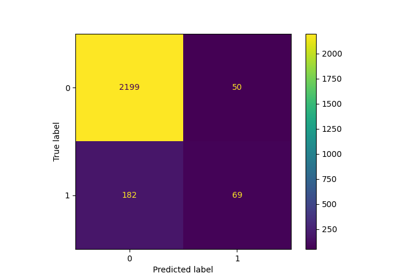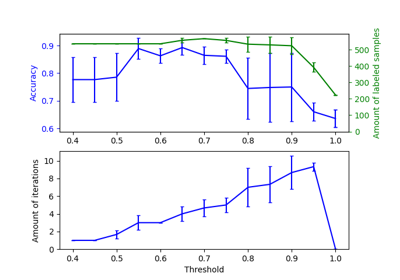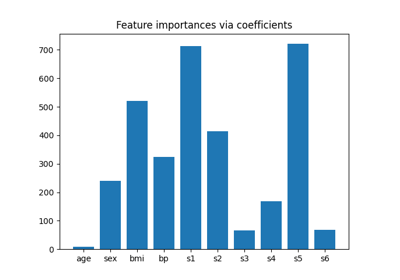备注
Go to the end 下载完整的示例代码。或者通过浏览器中的MysterLite或Binder运行此示例
事后调整决策函数的截止点#
一旦训练了二元分类器, predict 方法输出对应于 decision_function 或 predict_proba 输出.默认阈值定义为后验概率估计0.5或决策分数0.0。然而,这种默认策略对于手头的任务来说可能不是最佳的。
此示例展示了如何使用 TunedThresholdClassifierCV 根据感兴趣的指标调整决策阈值。
# Authors: The scikit-learn developers
# SPDX-License-Identifier: BSD-3-Clause
糖尿病数据集#
为了说明决策阈值的调整,我们将使用糖尿病数据集。该数据集可在OpenML上获取:https://www.openml.org/d/37。公司现采用国际 fetch_openml 函数获取此数据集。
from sklearn.datasets import fetch_openml
diabetes = fetch_openml(data_id=37, as_frame=True, parser="pandas")
data, target = diabetes.data, diabetes.target
我们查看目标以了解我们正在处理的问题类型。
target.value_counts()
class
tested_negative 500
tested_positive 268
Name: count, dtype: int64
我们可以看到我们正在处理一个二元分类问题。由于标签没有编码为0和1,因此我们明确表示,我们将标记为“tested_negative”的类视为负类(这也是最常见的),将标记为“tested_negative”的类视为正类:
neg_label, pos_label = target.value_counts().index
我们还可以观察到,这个二元问题是稍微不平衡的,我们有大约两倍多的样本来自负类比来自正类。当谈到评价时,我们应该考虑这方面来解释结果。
我们的香草分类器#
我们定义了一个基本的预测模型,该模型由缩放器和逻辑回归分类器组成。
from sklearn.linear_model import LogisticRegression
from sklearn.pipeline import make_pipeline
from sklearn.preprocessing import StandardScaler
model = make_pipeline(StandardScaler(), LogisticRegression())
model
我们使用交叉验证来评估我们的模型。我们使用准确度和平衡准确度来报告模型的性能。平衡准确度是一个对类不平衡不太敏感的指标,它将允许我们正确看待准确度得分。
交叉验证使我们能够研究不同数据分割之间决策阈值的方差。然而,数据集相当小,使用超过5倍来评估分散度是有害的。因此,我们使用 RepeatedStratifiedKFold 其中我们应用5重交叉验证的几次重复。
import pandas as pd
from sklearn.model_selection import RepeatedStratifiedKFold, cross_validate
scoring = ["accuracy", "balanced_accuracy"]
cv_scores = [
"train_accuracy",
"test_accuracy",
"train_balanced_accuracy",
"test_balanced_accuracy",
]
cv = RepeatedStratifiedKFold(n_splits=5, n_repeats=10, random_state=42)
cv_results_vanilla_model = pd.DataFrame(
cross_validate(
model,
data,
target,
scoring=scoring,
cv=cv,
return_train_score=True,
return_estimator=True,
)
)
cv_results_vanilla_model[cv_scores].aggregate(["mean", "std"]).T
我们的预测模型成功地掌握了数据与目标之间的关系。训练和测试分数彼此接近,这意味着我们的预测模型并没有过度适合。我们还可以观察到,由于前面提到的类别不平衡,平衡准确性低于准确性。
对于这个分类器,我们让决策阈值(用于将正类的概率转换为类预测)为其默认值:0.5。然而,这个阈值可能不是最佳的。如果我们的兴趣是最大化平衡准确性,那么我们应该选择另一个阈值来最大化该指标。
的 TunedThresholdClassifierCV 元估计器允许在给定感兴趣的指标的情况下调整分类器的决策阈值。
调整决策阈值#
我们创建一个 TunedThresholdClassifierCV 并将其配置为最大限度地提高平衡准确性。我们使用与以前相同的交叉验证策略来评估模型。
from sklearn.model_selection import TunedThresholdClassifierCV
tuned_model = TunedThresholdClassifierCV(estimator=model, scoring="balanced_accuracy")
cv_results_tuned_model = pd.DataFrame(
cross_validate(
tuned_model,
data,
target,
scoring=scoring,
cv=cv,
return_train_score=True,
return_estimator=True,
)
)
cv_results_tuned_model[cv_scores].aggregate(["mean", "std"]).T
与vanilla模型相比,我们观察到平衡准确度得分增加。当然,这是以较低的准确性得分为代价的。这意味着我们的模型现在对正类更敏感,但在负类上会犯更多错误。
然而,重要的是要注意,这个调整后的预测模型在内部与香草模型相同:它们具有相同的匹配系数。
import matplotlib.pyplot as plt
vanilla_model_coef = pd.DataFrame(
[est[-1].coef_.ravel() for est in cv_results_vanilla_model["estimator"]],
columns=diabetes.feature_names,
)
tuned_model_coef = pd.DataFrame(
[est.estimator_[-1].coef_.ravel() for est in cv_results_tuned_model["estimator"]],
columns=diabetes.feature_names,
)
fig, ax = plt.subplots(ncols=2, figsize=(12, 4), sharex=True, sharey=True)
vanilla_model_coef.boxplot(ax=ax[0])
ax[0].set_ylabel("Coefficient value")
ax[0].set_title("Vanilla model")
tuned_model_coef.boxplot(ax=ax[1])
ax[1].set_title("Tuned model")
_ = fig.suptitle("Coefficients of the predictive models")
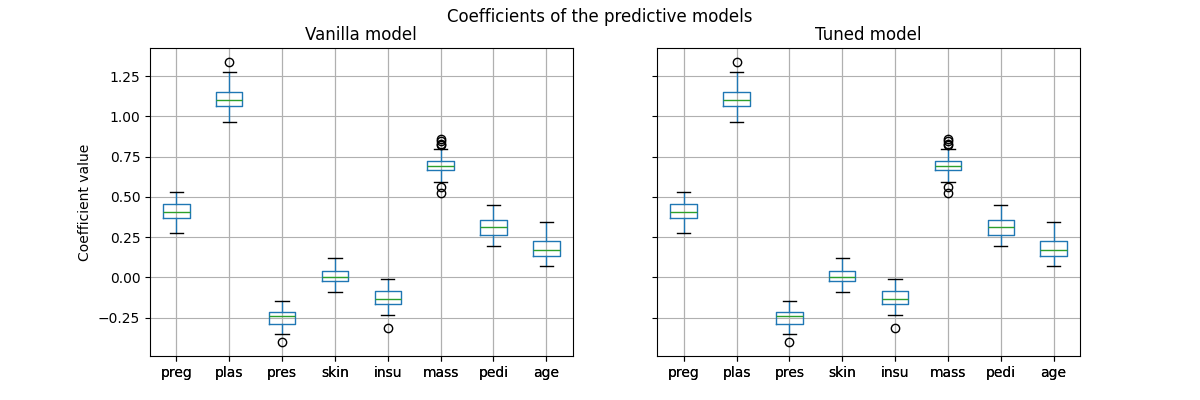
交叉验证期间仅改变了每个模型的决策阈值。
decision_threshold = pd.Series(
[est.best_threshold_ for est in cv_results_tuned_model["estimator"]],
)
ax = decision_threshold.plot.kde()
ax.axvline(
decision_threshold.mean(),
color="k",
linestyle="--",
label=f"Mean decision threshold: {decision_threshold.mean():.2f}",
)
ax.set_xlabel("Decision threshold")
ax.legend(loc="upper right")
_ = ax.set_title(
"Distribution of the decision threshold \nacross different cross-validation folds"
)
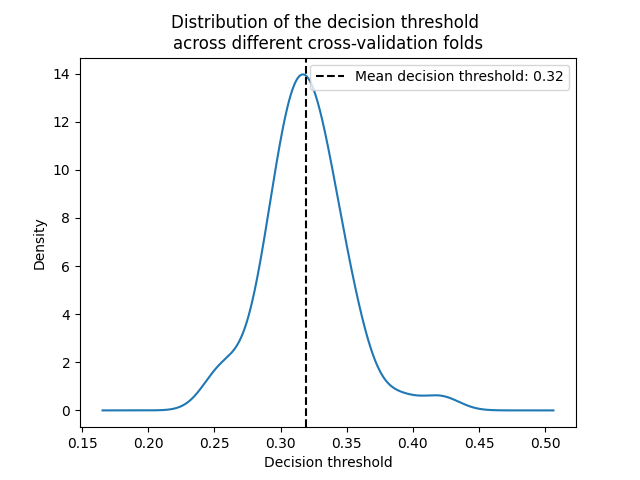
平均而言,0.32左右的决策阈值可以最大化平衡准确性,这与默认决策阈值0.5不同。因此,当使用预测模型的输出来做出决策时,调整决策阈值尤其重要。此外,应仔细选择用于调整决策阈值的指标。在这里,我们使用了平衡的准确性,但它可能不是当前问题的最合适的指标。“正确”指标的选择通常取决于问题,并且可能需要一些领域知识。请参阅标题为, sphx_glr_auto_examples_model_selection_plot_cost_sensitive_learning.py ,了解更多详细信息。
Total running time of the script: (0分29.704秒)
相关实例
Gallery generated by Sphinx-Gallery <https://sphinx-gallery.github.io> _

